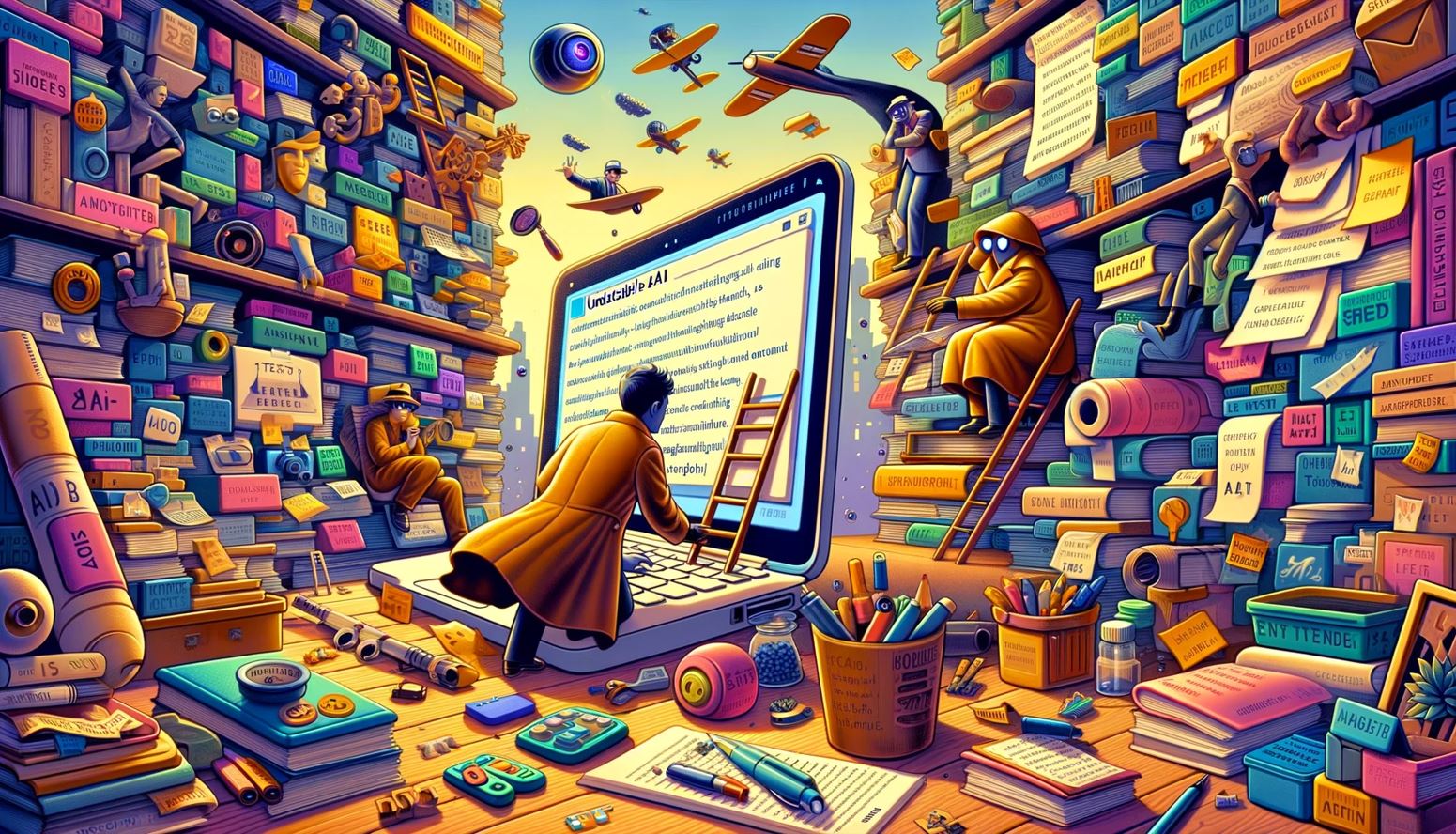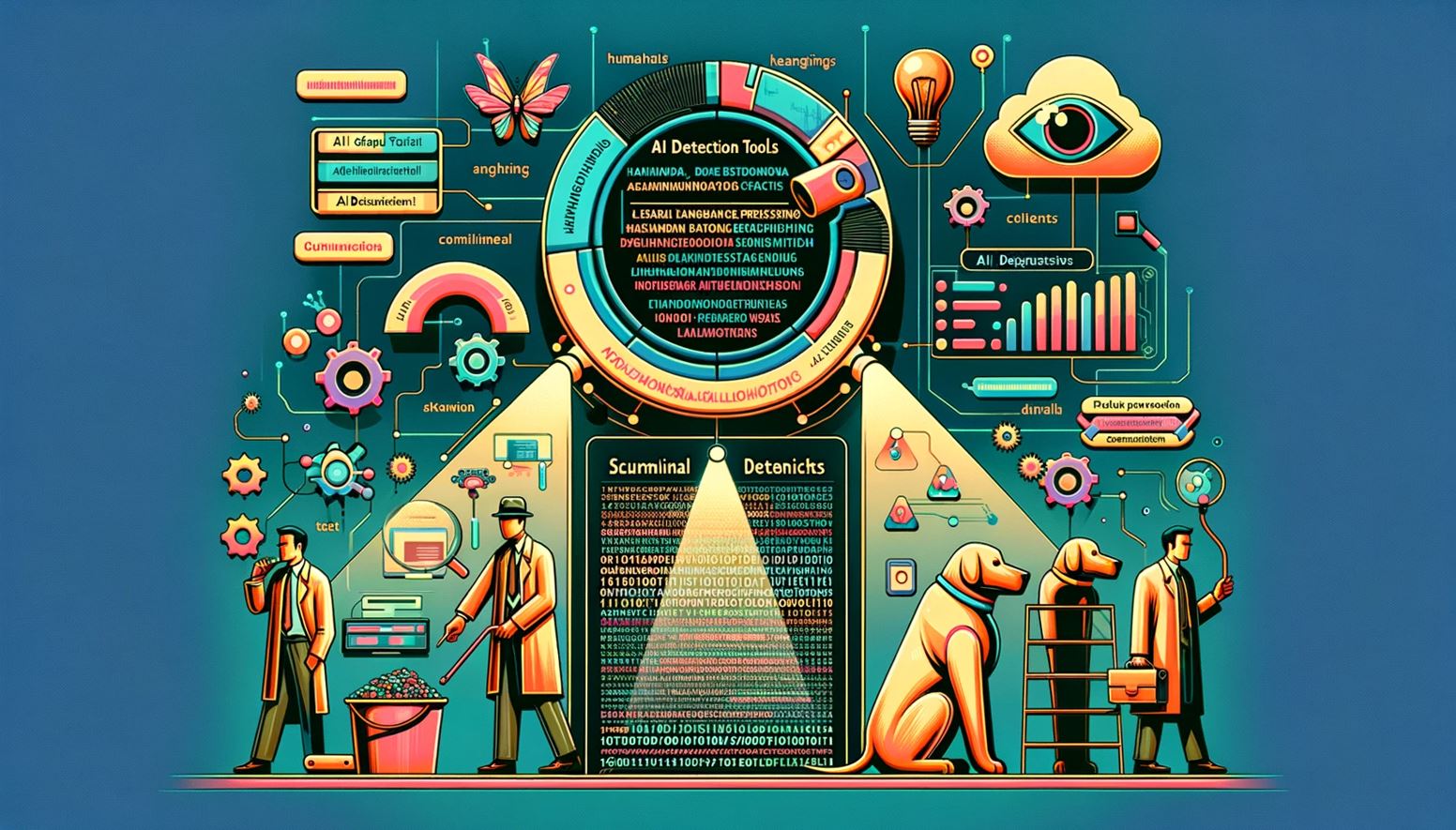Ever found yourself in a pickle, trying to keep your writing under the radar from those brainy AI detectors? Then it’s about time you learn how to avoid AI text detection.
Whether you’re a student aiming for originality or just someone who likes keeping things personal, avoiding AI recognition can feel like walking through a digital minefield.
Here’s the scoop: tools like Undetectable AI are the new secret handshake among folks eager to give their text that human glow.

Try these new AI-powered tools:
- 5 Best AI Detectors To Unmask AI-Written Content With Accuracy
- 5 Best AI Writers To Boost Your Productivity And Content Quality.
- This "Secret AI Writer" Can Bypass AI Detection Like A Pro.
And guess what? Even with AI being smarter than a whip-cracking spelling bee champ, there are still ways to slip past its ever-watchful eyes.
This nifty blog post is going to spill all the beans on how you can tweak your sentences and sprinkle in words as unique as your grandma’s secret cookie recipe – making sure your words stay yours.
You might be thinking …. why bother playing hide-and-seek with AI? Hold tight ’cause we’re diving deep into why it matters more than you think (hello academic integrity!), and how dodging these electronic bloodhounds isn’t just clever but crucial.
Ready for some tips that’ll have AI scratching its head while your writing shines? Let’s roll! It’s time to learn how to avoid AI text detection.
Article At-A-Glance
- Switch up your writing by using tools like Undetectable AI to make the text seem human and by changing sentence structures.
- Use different words and synonyms, and rewrite your own way to keep AI from guessing you got help.
- Understanding how AI detection tools work can help you stay ahead and avoid having your work marked as computer-made.
- Keeping work original is important for school honesty and a good name in college or job hunting.
- Edit manually, use personal stories, and shake things up with unique words so robots think it’s all you.
Table Of Contents
Tips On How To Avoid AI Text Detection
Hey there, rebels of the written word! So, you wanna give those smarty-pants AI detectors the slip? I’ve got some smooth moves up my sleeve that’ll have you dodging digital detection like a pro.
Keep it hush-hush though because we’re about to outfox the text bots and keep our human charm in check. Dive in, and let’s get crafty with words!
Use Undetectable AI
Undetectable AI steps up the game to sneak past those pesky AI detectors. Think of it as a super-spy disguise for your words—it dresses them up so the guards won’t even blink an eye.
It’s as if you have an invisible cloak for your text, making it look and sound human enough to trick the machines.
Sure, you might be using AI to help with writing, but Undetectable AI keeps that our little secret. It scrambles the digital scent that plagiarism tools sniff out—so even Turnitin gives it a nod and lets it pass by without suspicion.
This clever tool is all about staying one step ahead, keeping your work safe from being tagged as just another robot job.
Change In Sentence Structure
Switching up how you put together sentences can really throw AI off your track. You could start by playing with the length—mix short and snappy ones with longer, winding types. Think of it like a game of disguise. When your writing style changes, so does the sentence structure—and poof! You just might slip past that pesky AI detection.
So, let’s get crafty with our words. Shuffle those sentences around. Maybe flip them upside down or give them a good twirl. Got a common way to say something? Spin it into something new! This dance of words isn’t just fun—it keeps the robots guessing and your writing feeling fresh and real.
Unique Word Choice And Logical Flow
Picking just the right words makes your writing stand out. Like choosing a different path to reach the same place – it can trip up an AI that’s looking for familiar routes. By using varied vocabulary and steering clear of saying things in the same old way, you dodge AI content detection pretty well.
Think of it as putting on a disguise so the AI doesn’t recognize you.
Your writing needs to make sense too, flowing smoothly from one point to another. This means ideas connect like pieces in a puzzle, making it tough for AI tools to spot anything unusual.
Your writing needs to make sense too, flowing smoothly from one point to another. This means ideas connect like pieces in a puzzle, making it tough for AI tools to spot anything unusual.
A story that glides seamlessly might just slip past those pesky digital gatekeepers since they’re scrounging around for clunky, robotic patterns instead.
Incorporating Synonyms And Paraphrasing
So, you’ve got the unique words and the logic down. Now let’s shake things up a bit more with synonyms and paraphrasing. Think of it like a secret code—switching out words to throw off that pesky AI.
Spice up your sentences by using different phrasing that means the same thing. It’s about altering the wording without messing with the message.
Grabbing QuillBot or just diving into your own vocab vault can be super handy here. Tweak those sentences! Maybe “The quick brown fox jumps over the lazy dog” turns into “A speedy russet fox leaps above a snoozy pooch.” You keep the core idea but give it a new coat of paint.
Keep this up, mix it around, make it yours—and poof! That AI won’t know what hit it because now your writing sounds just like you, not some robot.
Manual Editing And Rewriting
Manual editing and rewriting turn your work into something that seems like a real person wrote it. It’s a smart way to keep AI detectors from catching on.
- Grab that draft you’ve written with the help of AI. Now, get ready to give it a touch of human brilliance.
- Read through each sentence carefully. Ask yourself, “Does this sound like me?” Change it if it doesn’t.
- Mix up your sentence lengths and structures. Your writing should dance, not march.
- Dive into the world of synonyms, but don’t just pick any old word. Choose ones that fit perfectly.
- Paraphrasing isn’t just for avoiding trouble. It’s your chance to shine! Put things in your own words.
- Sometimes you’ve got to roll up your sleeves and rewrite whole paragraphs. Tough? Sure, but worth it!
- Remember those personal stories only you can tell? Sprinkle them in. They’ll make your writing sparkle.
- Check out tools like Undetectable AI. They’re made for this kind of sneakiness—but don’t rely on them too much!
- Getting another pair of eyes on your work is golden. A friend or a tutor might see things you missed.
- If something feels stiff or formal, loosen it up! Write like you’re chatting with a friend over lunch.
Understanding AI Detection Tools
Alright, let’s dive into the nitty-gritty of AI detection tools without dishing out a snooze fest. Imagine these cyber bloodhounds – sniffing around every word and comma for that whiff of AI-generated text. Understanding their tricks is your ticket to staying one step ahead.
What Are AI Detection Tools?
AI detection tools are like smart detectives that look for clues in writing. They scan your words to see if a computer helped make them. These tools have big lists of stuff that AI writes and they check your work against those lists.
If they find matches, they might say your work was not written by you alone.
These smart programs also pay attention to the way sentences are built and how words dance together. Think of them like teachers who can spot when something doesn’t sound quite right—too perfect or too odd—and wave a red flag.
Some names you might know are Copyleaks AI Content Detector and Google’s Detect AI Content.
Now, let’s dive into how these clever tools actually do their job.
How Do AI Detection Tools Work?
Artificial intelligence is smart, but it’s got a tell. Think of AI detection tools as detectives. They look for clues in the words we write. These tools use natural language processing (NLP) to get what our text is all about.
Then they put machine learning algorithms to work. Like hounds sniffing out treats, these algorithms hunt for signs that a robot helped make the text.
They take piles of data from books, websites, and articles to learn what human writing sounds like. Next up? The big test! Scanning through your work, they’re on the lookout for stuff like weird word patterns or sentences that seem offbeat—that’s how they spot if it’s possibly penned by an AI buddy.
And before you know it, voila—they’ve figured out if you had some robotic help along the way!
Why Avoid AI Detection In Writing?
Ducking under the AI detection radar isn’t just cloak-and-dagger fun—it’s serious business, folks. Imagine you’ve poured your heart into a thesis or research paper. You don’t want it tagged as ‘AI-generated’—that’s like wearing someone else’s nametag at your own party!

Maintaining Academic Integrity
Keeping it real in school means not cheating or copying, right? That’s what academic integrity is all about. Think of it as playing by the rules when you’re writing papers or doing homework.
Schools have tools that check if you wrote something yourself or just got it from somewhere else.
Now, imagine a teacher using a special tool to see if your essay was written by a computer or by you. They’re like detectives looking for clues! If they find out you didn’t write it, that’s big trouble.
So it’s super important to do your own work and show what *you* know – not what some smart computer knows.
So why should students care? Well, learning stuff on your own helps you get smarter and do better later in life – like getting into college or landing an awesome job. And let’s face it: nobody wants to be known as the person who cheats! It messes up trust with teachers and friends.
That’s why schools are fighting back against cheating with things called “scaffold writing assignments.” These help make sure everyone’s playing fair. After all, honesty makes everything better at school for everyone involved.
Benefits For Students
So you’re thinking of skipping the AI text detectors, huh? Well, guess what—doing things the old-fashioned way can seriously level up your game. First off, we’re talking about boosting those brain muscles! Diving into manual editing and rewriting sharpens your writing skills like nobody’s business.
You learn to spot mistakes and fix ’em on the fly.
Plus, there’s this super important thing called academic integrity. It’s all about being honest in your work. Now imagine creating something that’s 100% you—now that’s a confidence booster! Not to mention, teachers dig it when you turn in work that screams originality and creativity.
It shows them you’ve got what it takes to think critically and come up with fresh ideas.
And hey, don’t forget about educational outcomes—that fancy term for how much you actually learn and remember. By dodging those AI detectors through good ol’ human smarts, you’re setting yourself up for some pretty awesome results down the road.
Really makes sense when you think about it—put in the effort now, and reap the rewards later!
Importance For Academic Reputation
Having a strong academic reputation is like holding a golden ticket. It opens doors to awesome schools and cool jobs. Now, if people think you use AI to do your homework, that shiny rep can take a big hit.
Schools care about honesty because it shows the real work of students—how smart they are, and how hard they poke at problems until they solve them.
Schools care about honesty because it shows the real work of students—how smart they are, and how hard they poke at problems until they solve them.
Imagine this: You’ve worked super hard on an essay for college. But what if the tools checking your paper are mixed up? They might say you cheated when you didn’t! That’s scary stuff because it could smear your name.
Even worse, colleges get shaky knees thinking their students might not be doing their own work. This makes everyone look bad—students and schools alike—and nobody wants that mess!
Infuse Your Unique StyleTo Avoid AI Text Detection
So, you want to keep AI from spotting your text? Here’s the deal. First off, mix it up with tools that swap out words without losing your point. Also, don’t just let a computer write for you—throw in your own style! And get this: toss in some of your real-life tales to make things more human.
Remember, tweak those sentences and pick different words so computers can’t guess it’s not you. Trust me, it’s kinda like wearing a disguise that fools even smart robots! Now go on—try these tricks and see how they work magic for you.
Lastly, if curiosity is still buzzing in your head – consider more resources because there are heaps out there! Keep writing cool stuff and watch as no AI can lay a finger on your work.
FAQs
1. What’s the trick to keeping my writing from being tagged as AI-generated?
Try adding your own flair and personal stories to make it sound like you’re just chatting with a friend.
2. Can I use big, fancy words to fool the AI detectors?
Actually, sticking to simple language that sounds human might work better!
3. Should I throw in some jokes or slang to seem more human?
Absolutely, a good laugh or casual talk could totally give your writing that human touch!
4. Is there any point in messing up my grammar on purpose?
Well… using perfect grammar can sometimes be a giveaway, so why not loosen up a bit?
5. If I write about really odd topics, will that keep me under the radar?
Yep, talking about weird stuff can definitely throw those detectors off your trail.
Meet our resident tech wizard, Steve the AI Guy. Now, before you get any wild ideas, let’s clear up one thing – he’s 100% human! I mean, he’s got the work history to prove it. He spent a decade diving into the deep end of the tech industry doing business intelligence work, splashing around with two of the world’s largest business consulting companies, Deloitte and Ernst & Young. Learn More










